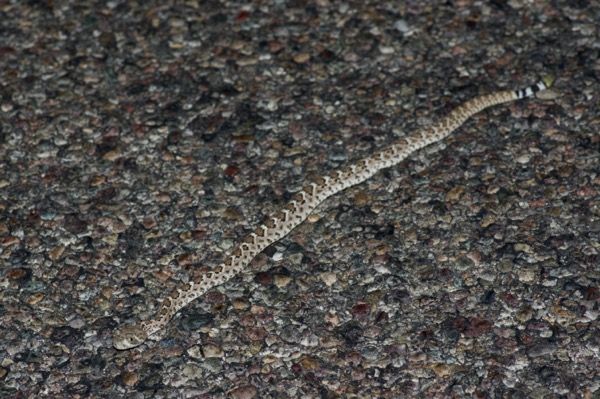Crotalus atrox
—
Western Diamond-backed Rattlesnake
Also known as:
Western Diamondback Rattlesnake
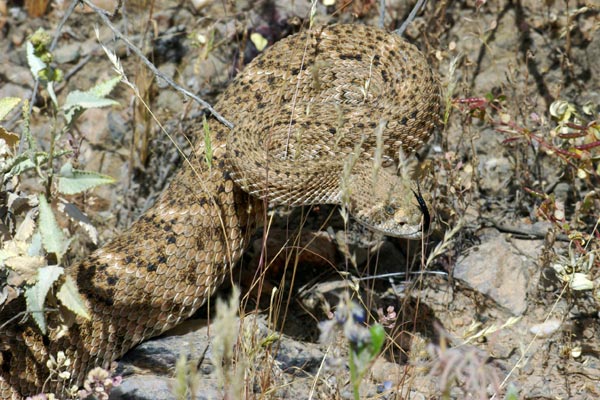
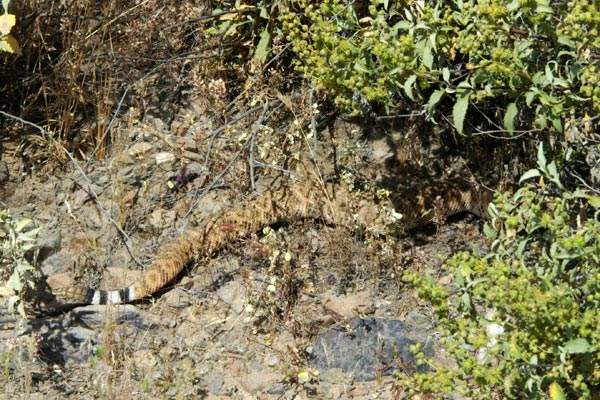
This is one of the most common rattlesnakes in the western U.S., if not the most common, yet I had somehow managed to avoid seeing one until now. They look pretty similar to Mohave Rattlesnakes from a distance, which is where you should generally be when viewing rattlesnakes. One giveaway here is the more or less even widths of the black and white bands on the tail, a feature that has earned this species the nickname of "coontail rattler".
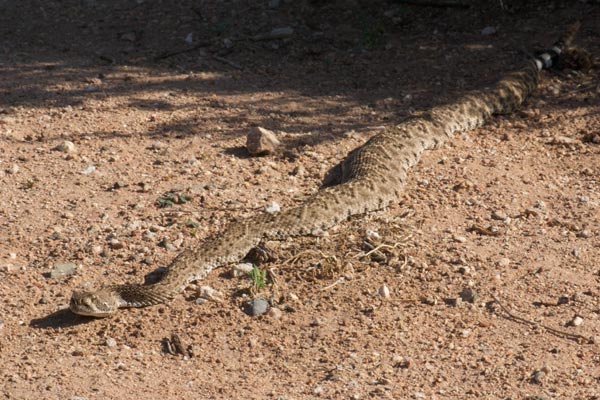
I was following an annoyingly slow but uncooperative whiptail around our campsite, when it meandered around a bush. I followed it around that bush, not for the first time that day, when I noticed this fine fellow stretched out lazily, blocking my way. Since I had my camera with me for (temporarily interrupted) whiptail-photographing, I settled in and took a few photos of my newfound much-more-cooperative friend. Then I went back to tell my wife Monica and sister Mary, who were on the other side of the bush, perhaps twenty feet away. I got my rarely-used snake hook out with the thought of relocating our scaly friend a little further from the campsite. My sister and I walked back around the bush, but the snake was nowhere to be seen. Less than two minutes earlier, it looked like it was camped out for the evening, but now ... hmm.
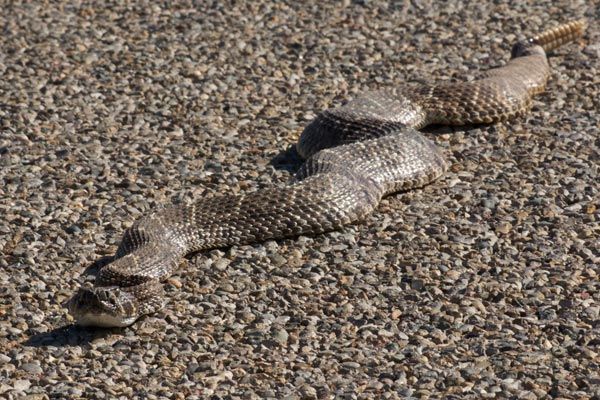
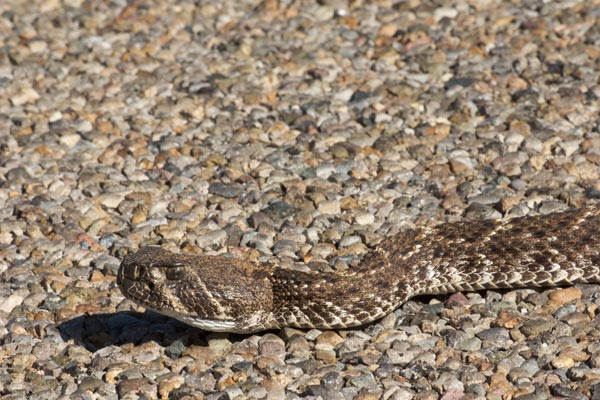
This very large rattler was in the same basic lazy basking position as the smaller one I had seen at our campsite the previous day. This one was in the middle of the road though. After getting these photos, I managed to convince it to leave the road using the extended legs of my tripod, while an impatient truck waited to pass.
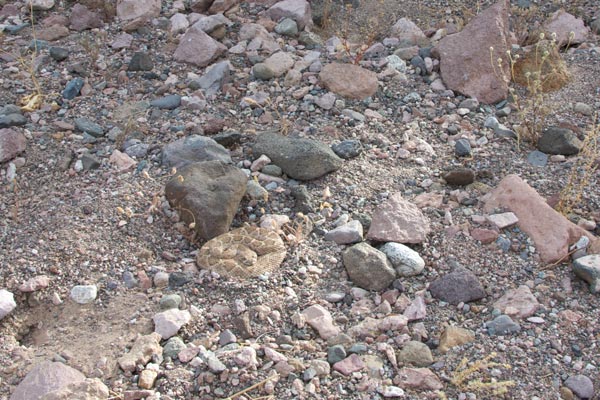
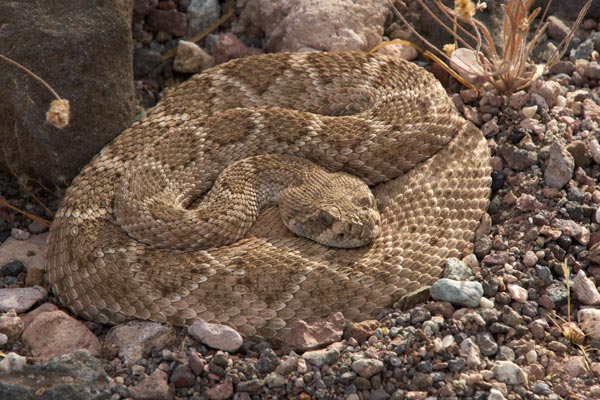
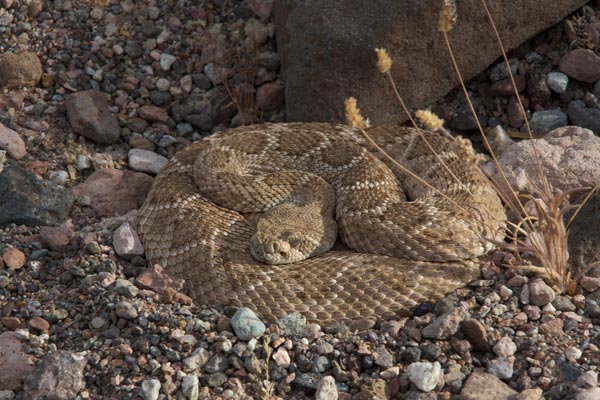
My wife and I and our five dogs camped one night in Senator Wash, which is on the California side of the Colorado River border with Arizona. In the morning, we took the four of them that are not old and blind on a nice walk along the reservoir and through a desert wash. Monica and the dogs were up front, and I was doing my usual glancing around for reptilian activity. I didn't notice any "activity", but I did notice that this rattlesnake was coiled up a few feet from where the others had passed.
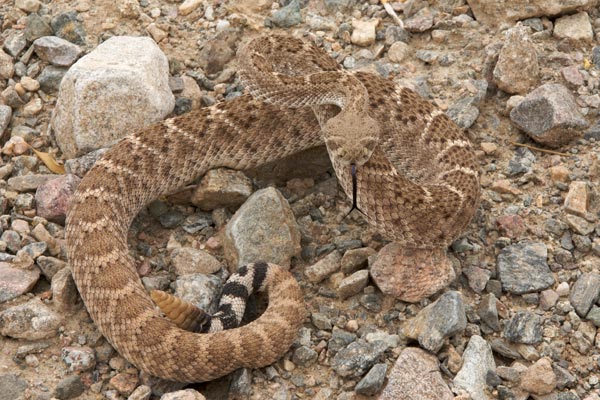
This rattlesnake was stretched out in a dirt parking lot along the road winding through Mittry Lake Wildlife Area as we drove past. When I came back to take some pictures, it first tried to backslide its way to freedom. When it slid back into the base of a small hill it switched tactics and went for the traditional I'm-a-scary-rattlesnake posture instead.
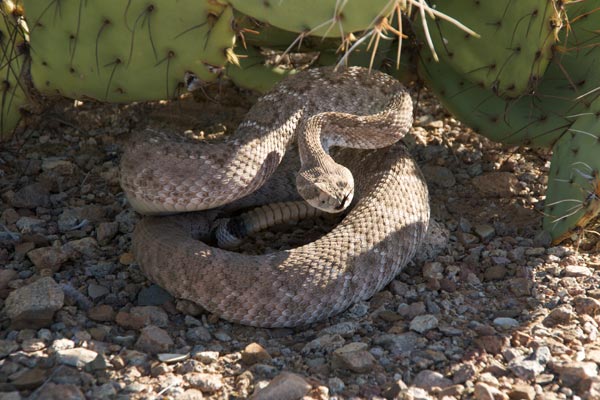
While staying at this park, we typically took our dogs on a morning hike through the adjacent desert. This rattlesnake didn't deter us, because like most snakes it just wanted to be left alone. Eventually the cholla clumps on the trail that stick *so* easily to little doggy feet, legs, and heads did deter us though.
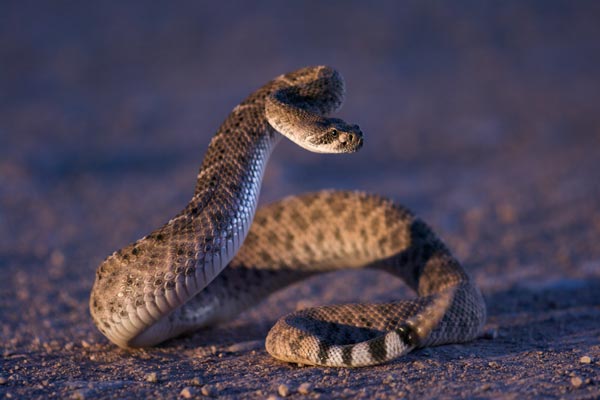
This rattlesnake was on the road right around dusk. It was too dark to take a photo using the natural light, but still just light enough that the natural light plus the car headlights made for a dramatic effect.
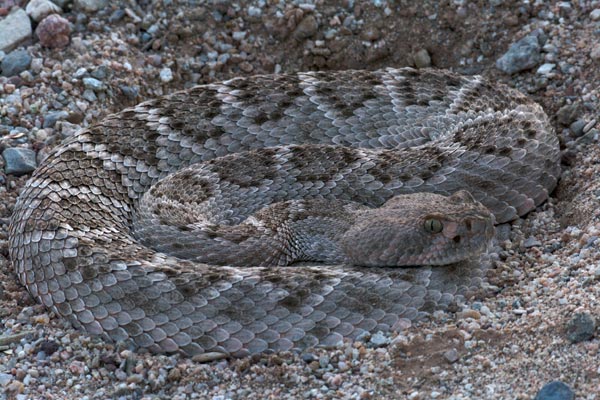
After Roger took data on the rattlesnake pictured above, we tracked a Gila Monster for long enough that it seemed worthwhile to check up on the large male rattlesnake that we had seen earlier with its head barely visible at the mouth of a burrow. Sure enough, it was no longer there. We followed the beeping antenna to find it a few dozen feet away, out in the open, camouflaged beautifully as it lay coiled in the sand.
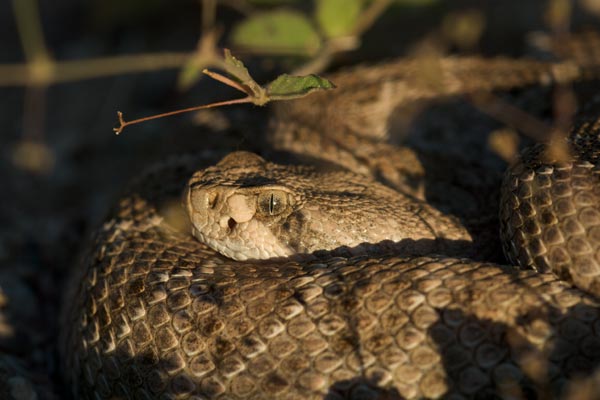
My friend Roger Repp is conducting long-term radio tracking studies in the Suizo mountains of these rattlesnakes, along with Tiger Rattlesnakes (Crotalus tigris) and Gila Monsters. I tagged along with him one evening and we sought out individuals of these three species. The two Tiger Rattlesnakes were not cooperative at all — they were both sheltering in rock crevices. An inch or two of one of them was just barely visible if you twisted your head to exactly the right angle and looked at exactly the right spot, and the other one was completely out of sight.
The Western Diamond-backed Rattlesnakes were more cooperative, on average. Roger tracked four of them, and only one was out of sight. A second was fairly well concealed in a bush, the head of a third was barely visible in the mouth of a burrow, and the fourth was the young female shown here, coiled up on the desert floor.
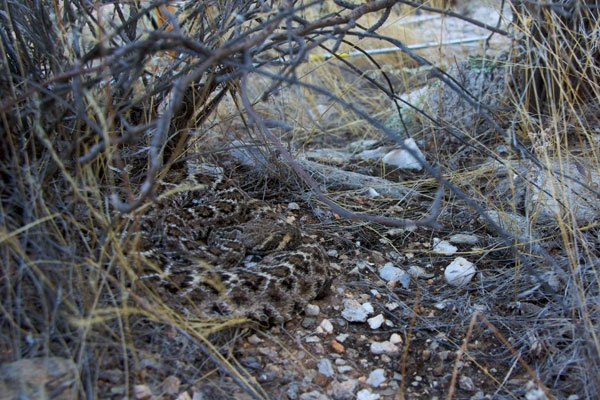
Here's another pretty young rattlesnake that was a recent addition to Roger Repp's study. We had a hard time finding this one even when Roger had narrowed its location down to an area of a few square feet.
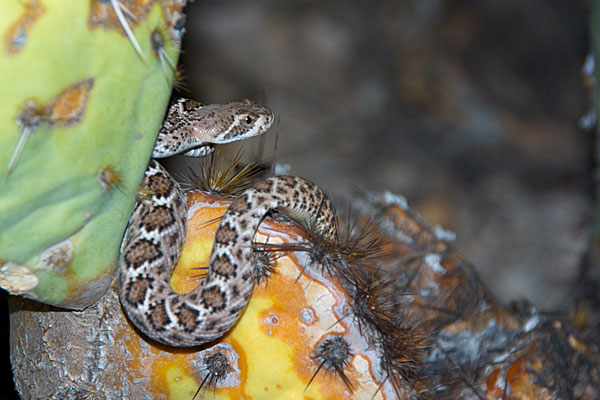
On a dry, moonlit evening, we were not expecting to have much luck looking for nocturnal reptiles. Our first evidence that the night had something to offer was this neonate rattlesnake, which Roger Repp and Ralph Shepstone spotted along a trail. When the rest of our group came over to admire it, the snake started moving and surprised us by climbing up the nearest prickly pear cactus and settling down.
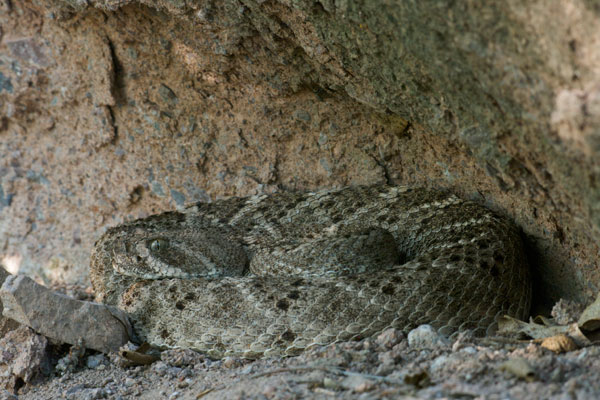
Roger Repp found this resting rattler in an area that Jeff Smith had chosen via Google Earh as a likely spot for Arizona Black Rattlesnakes. For a while this was the only snake any of us saw, and we all began to suspect that Google Earth had done Jeff wrong. But we shouldn't have doubted him.
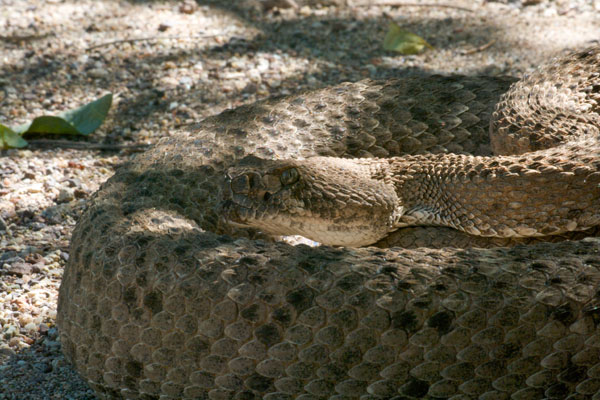
This monster was the biggest, thickest, and most grizzled Crotalus atrox I've yet seen. Its snout was disfigured, perhaps by some long-past battle with an orc. It was very mellow though, probably because it had learned patience in its many long years.
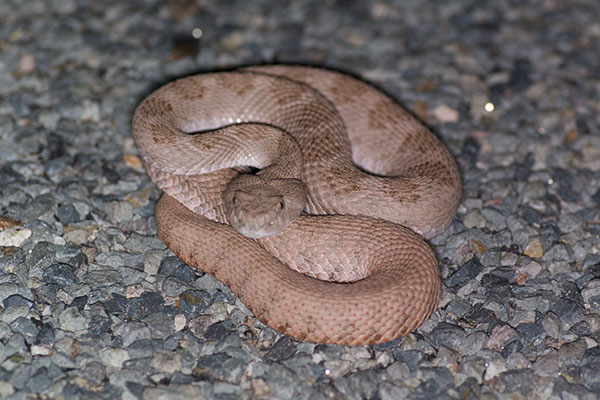
Most, maybe all, of the Crotalus atrox I saw in this area had a pronounced pink tint.
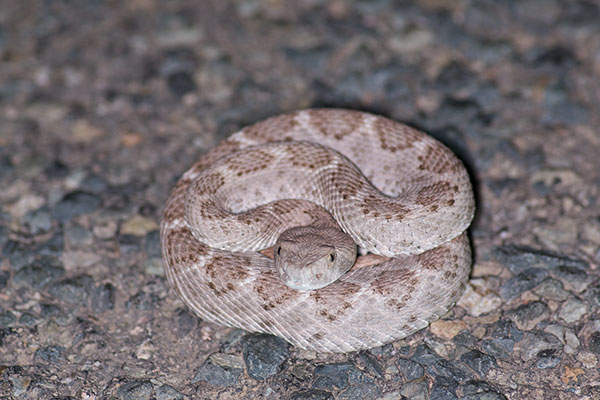
Here's another pinkish individual from the same area. Another trait these snakes shared was the habit of coiling up in a tight ball with the rattle hidden.
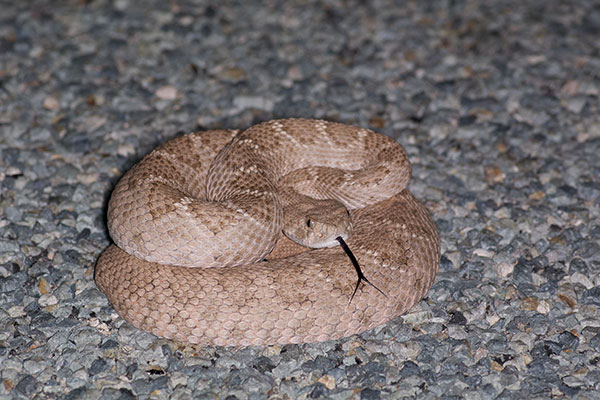
Another night, another pinkish diamond-backed rattlesnake in a tight coil hiding its rattle.
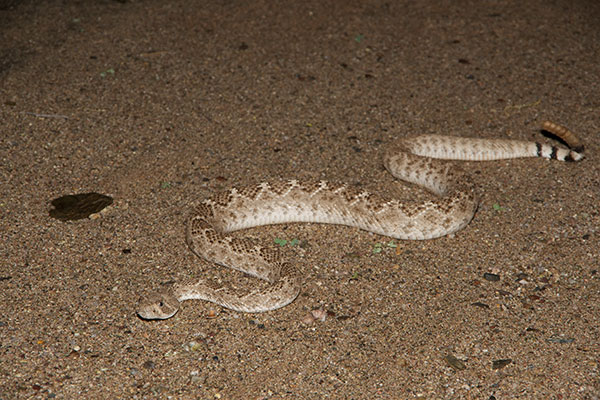
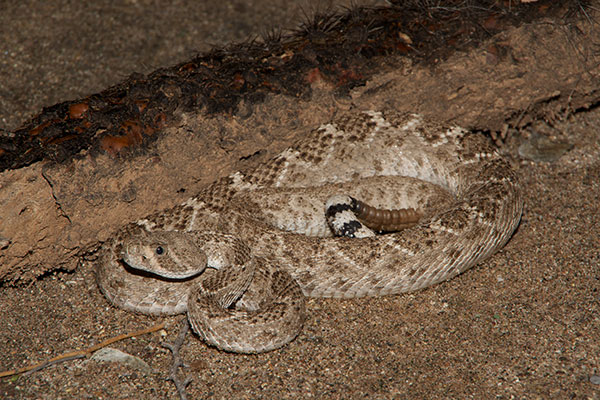
Roger Repp (Herp King of Southern Arizona, where the turtles are strong, the snakes are handsome, and the lizards are all above average) and I had been radio-tracking Black-tailed Rattlesnakes on his study plot when a Tiger Rattlesnake made a sudden appearance right in front of us. While I was taking photos of the Tiger, Roger shined his flashlight about ten feet away onto this one, which had been nicely coiled nearby. Once it learned that we were intending to take its picture, it disappeared into the bushes, but we wrangled it out for a few shots.
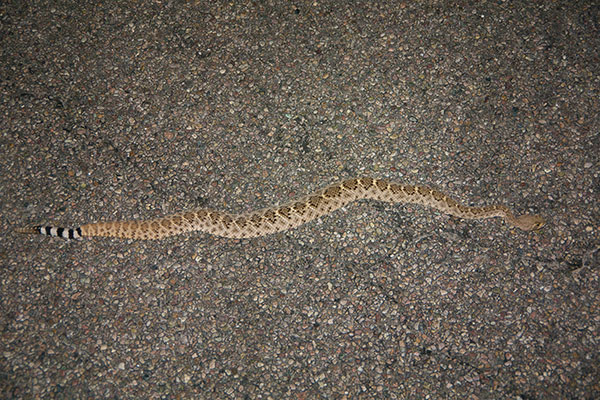
This adult seems to be modeling the perfect "coon stripe" tail that helps distinguish Crotalus atrox from similar-looking species.
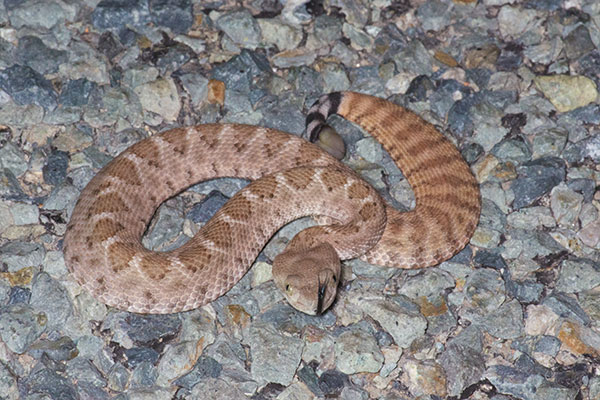
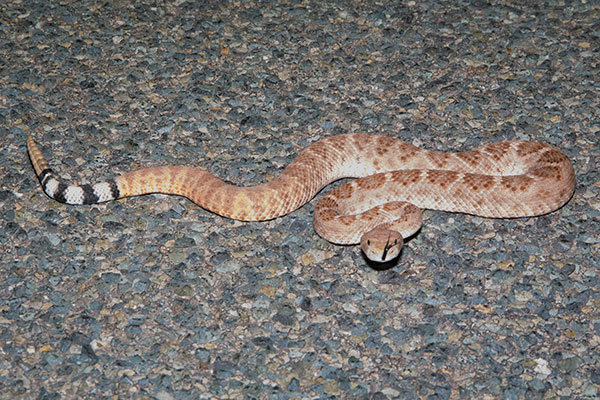
More pink snakes from the same area that had all the pink Crotalus atrox last year.
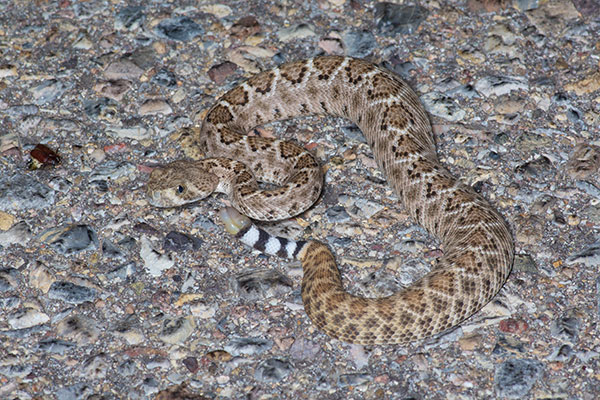
A more standard-colored C. atrox, from about 150 miles to the west of the pinkish ones pictured above. The button on the end of the tail shows that it's a tiny juvenile.
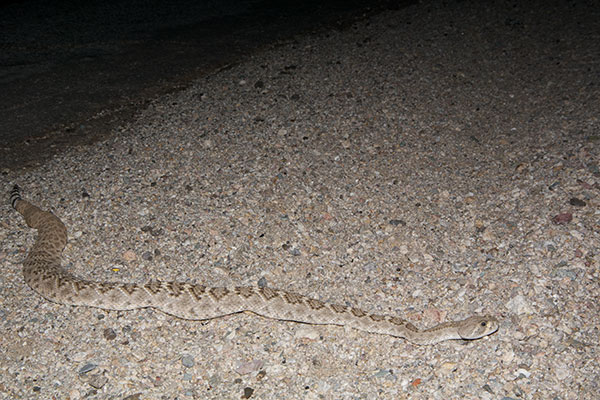
My favorite animal encounters are the ones where the animal doesn't move between the time I first see it and the time I leave it behind after taking photos. I don't always get the best photos in these cases, but I feel good about the encounter afterwards. This was one of those cases, where I spotted the snake mostly stretched out in a fairly awkward position at the edge of the road, and was still there when I left.

In this case, the rattlesnake was crawling across a dirt road when I saw it, but quickly coiled up in a defensive position when it saw me. If this had been a paved road I would have encouraged it to get off the road to avoid getting hit by a car, but the chances were very low that any other cars would be traveling this dirt road on this night, so I left it coiled up like this, feeling slightly guilty for having interrupted its evening.
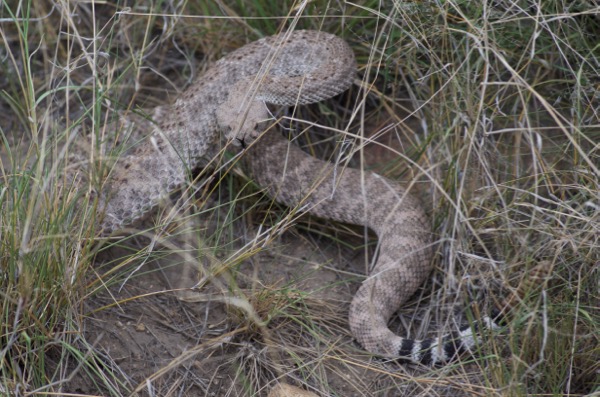
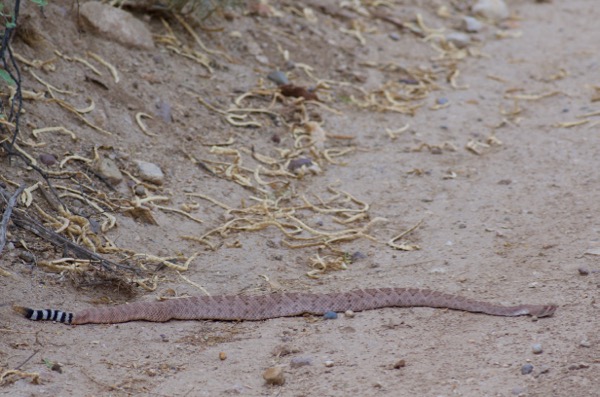
Here's a pair of adults I encountered about forty-five minutes apart one afternoon. I walked up on the first one, who noticed me just before I noticed it and reacted by rattling and pulling into a defensive position. The second one was stretched out on a dirt road that I was driving down. I took this picture from the car window to avoid spooking it.
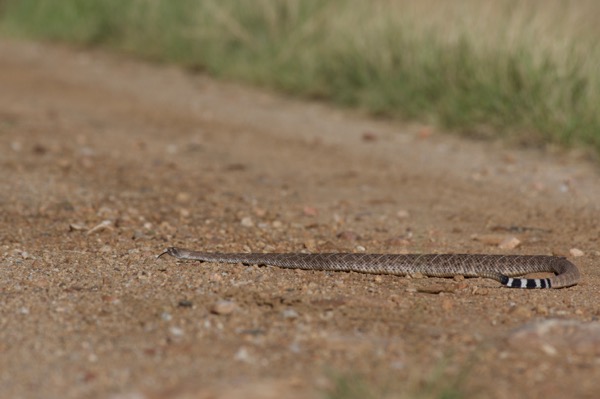
This rattler was stretched left-to-right across the gravel road when I came hiking around the corner. I saw it, it saw me, and it decided the left side of the road was better than the right side after all. I got a photo in mid rattler U-turn.
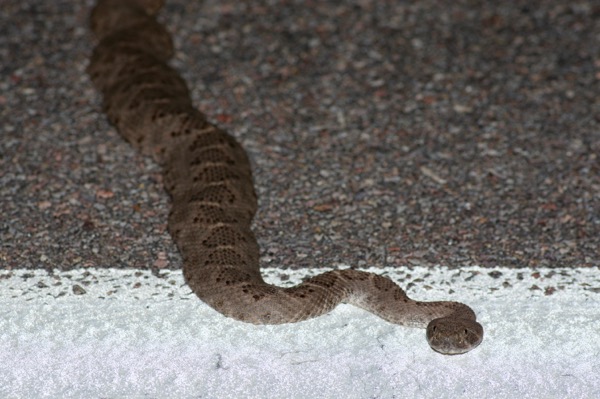
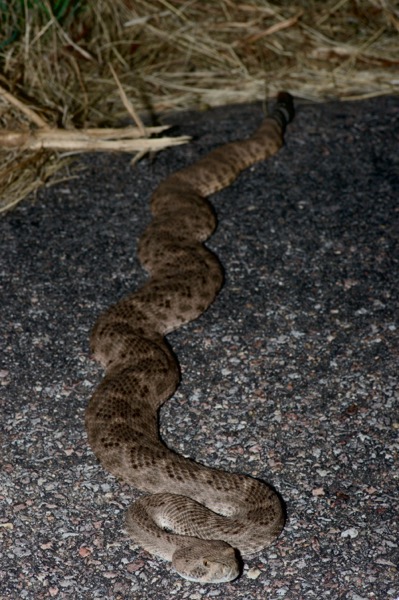
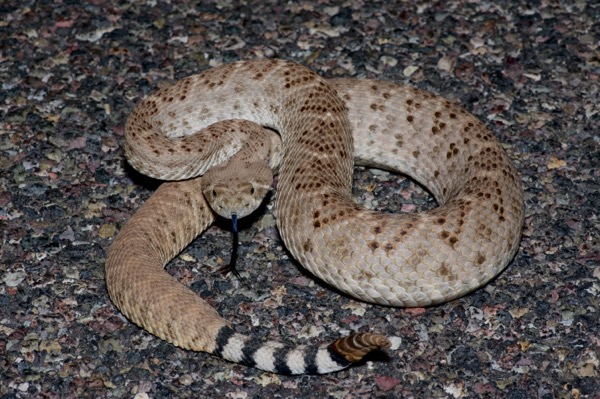
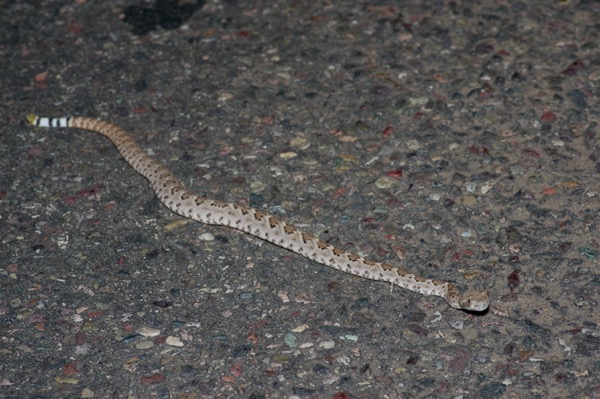
I saw seven or eight Crotalus atrox road-cruising on this night. The first two pictured above were big robust adults. The third one above was a medium-sized adult. The others were all youngsters, like the last one pictured above. Note that its tail has on average wider white bands than black bands. This is unusual for Western Diamond-backed Rattlesnakes but typical for Mohave Rattlesnakes, so one might be tempted to conclude that this is a baby Mohave rather than a baby Diamond-backed rattlesnake. However, it has numerous small scales on the top of the head between the big eye-covering scales, which is standard for this species; Mohave Rattlesnakes have two large scales there. So I think it's a baby Diamond-backed Rattlesnake with an aberrant tail-ring pattern.
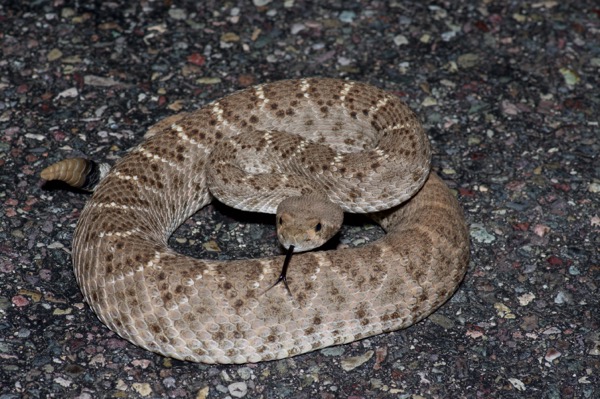
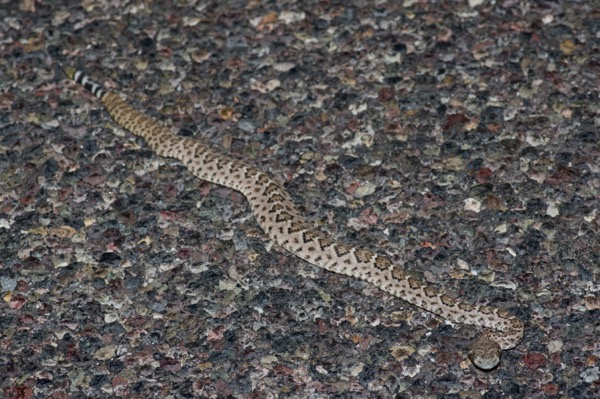
Another adult and another youngster from the next night. These are the most commonly seen snakes in the area, so I can't get too excited about seeing a few more standard-looking ones. Sorry Crotalus atrox. I still respect you!
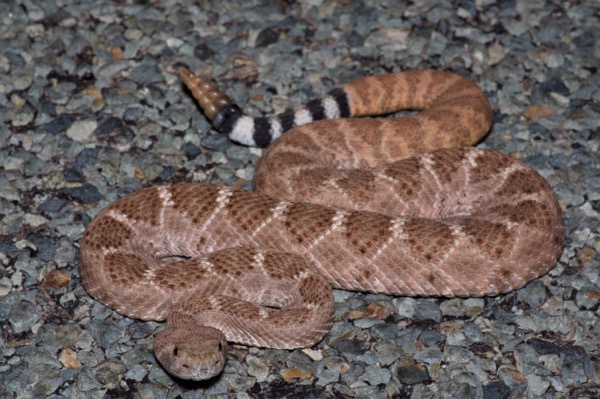
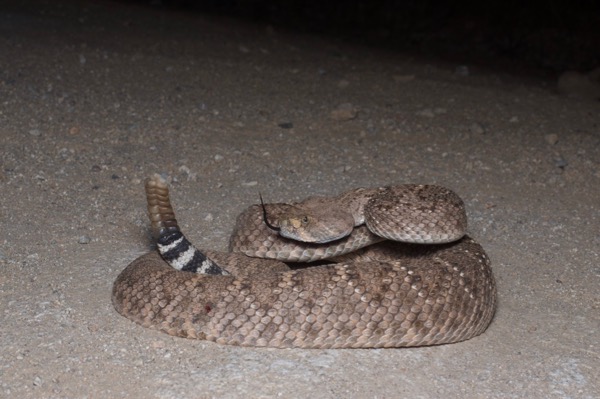
We looked for but failed to find any Arizona Black Rattlesnakes or even Sonoran Sidewinders. Our consolation prize was a couple of these common rattlers on the roads at night.
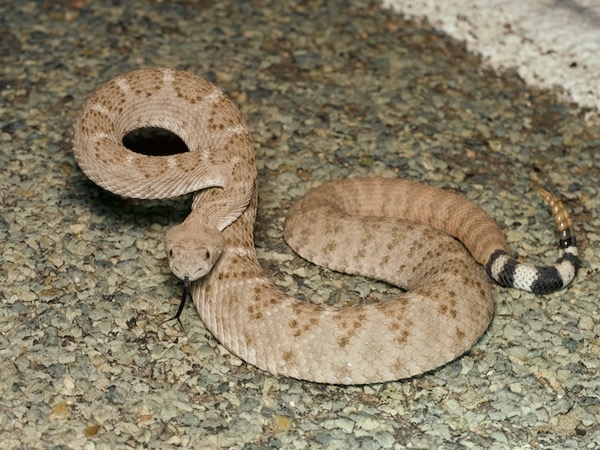
My first C. atrox of the trip was this reasonably large adult, on the edge of the road near dusk. I'm not so sure it was happy to see me.
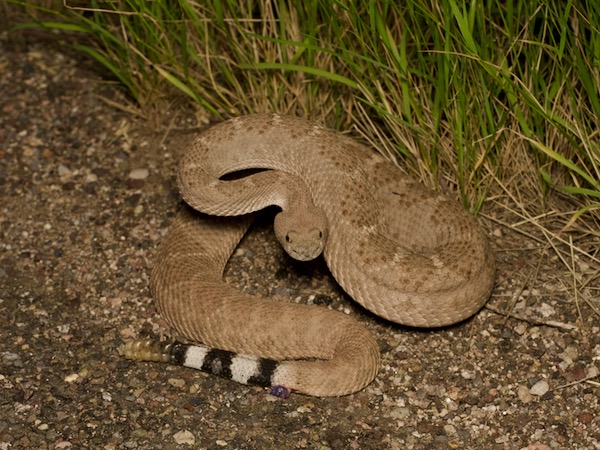
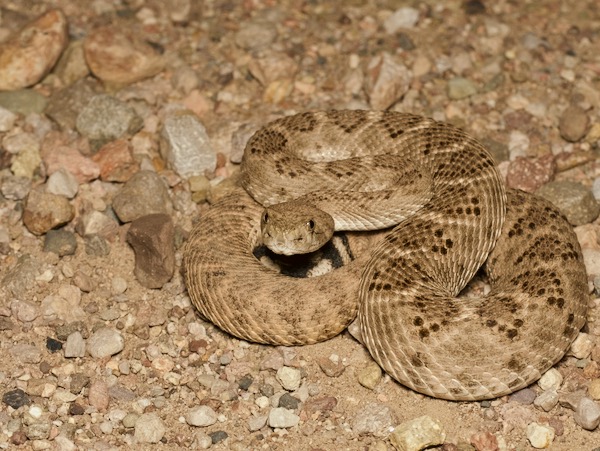
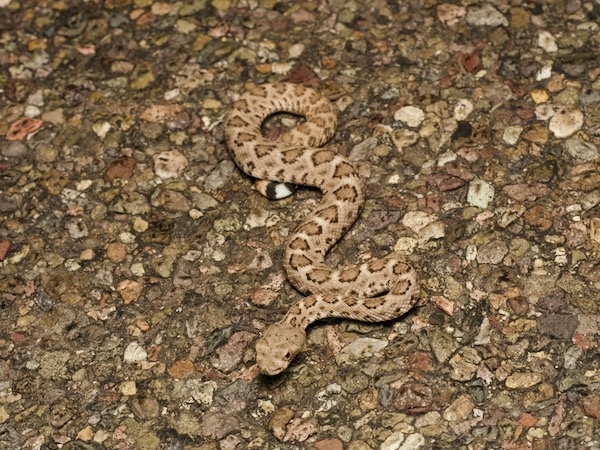
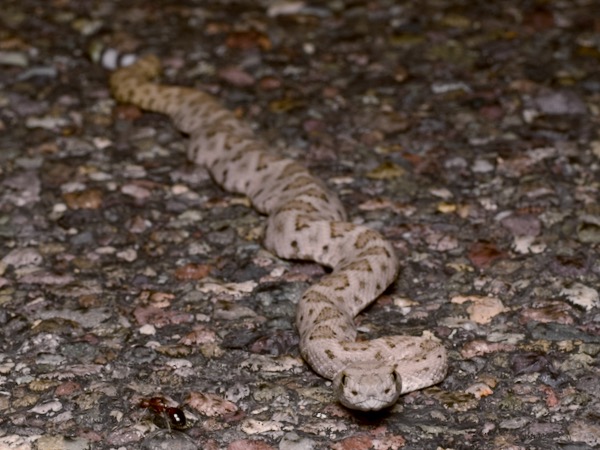
Plenty of Crotalus atrox to go around in this area.
Printed references:
- Bartlett, R. D., Tennant, A. 2000. Snakes of North America, Western Region
- Behler, J. L., King, F. W. 1979. The Audubon Society Field Guide to North American Reptiles & Amphibians
- Brennan, T. C. and Holycross, A. T. 2005. A Field Guide to Amphibians and Reptiles of Maricopa County
- Brennan, T. C. and Holycross, A. T. 2006. A Field Guide to Amphibians and Reptiles in Arizona
- Brown, P. R. 1997. A Field Guide to Snakes of California
- Crother, B. I. (ed.) 2017. Scientific and Standard English Names of Amphibians and Reptiles of North America North of Mexico, with Comments Regarding Confidence in Our Understanding, Eighth Edition
- Miller, A. H., Stebbins, R. C. 1973. The Lives of Desert Animals in Joshua Tree National Monument
- Smith, H. M., Brodie, E. D. Jr. 1982. Reptiles of North America: A Guide to Field Identification
- Stebbins, R. C. 2003. Peterson Field Guide to Western Reptiles and Amphibians, Third Edition
- Stoops, E. D., Wright, A. 1997. Snakes and other Reptiles of the Southwest, 4th Edition
